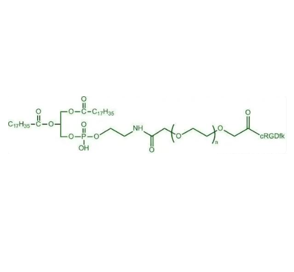文献:Herpesvirus-Mimicking DNAzyme-Loaded Nanoparticles as a Mitochondrial DNA Stress Inducer to Activate Innate Immunity for Tumor Therapy
文献链接:https://onlinelibrary.wiley.com/doi/abs/10.1002/adma.202204585
作者:Xiu Zhao , Yiyang Wang , Wenxiao Jiang , Qiongwei Wang , Jun Li , Zhiyang Wen , Airong Li , Kaixiang Zhang , Zhenzhong Zhang , Jinjin Shi , Junjie Liu
相关产品:DSPE-PEG2000-cRGD peptide(磷脂-聚乙二醇2000-cRGD肽)
原文摘要:
Virus-based immunotherapy is a promising approach to treat tumor. Closely mimicking the structure and sequential infection processes of natural viruses is highly desirable for effective tumor immunotherapy but remains challenging. Here, inspired by the robust innate immunity induced by herpesvirus, a herpesvirus-mimicking nanoparticle (named Vir-ZM@TD) is engineered for tumor therapy by mimicking the structure and infection processes of herpesvirus. In this biomimetic system, DNAzyme-loaded manganese‑doped zeolitic imidazolate framework‑90 (ZIF-90) nanoparticles (ZM@TD) mimic the virus nucleocapsid containing the genome; the erythrocyte membrane mimics the viral envelope; and two functional peptides, RGD and HA2 peptides, resemble the surface glycoprotein spikes of herpesvirus. Vir-ZM@TD can both effectively evade rapid clearance in the blood circulation and closely mimic the serial infection processes of herpesvirus, including specific tumor targeting, membrane fusion-mediated endosomal escape, and TFAM (transcription factor A, mitochondrial) deficiency-triggered mitochondrial DNA stress, as well as the release of manganese ions (Mn2+) from organelles into the cytosol, ultimately effectively priming cGAS-STING pathway-mediated innate immunity with 68% complete regression of primary tumors and extending by 32 days the median survival time of 4T1-tumor-bearing mice.
DSPE-PEG2000-cRGD peptide:DSPE(1,2 -二硬脂酰- sn -甘油- 3 -磷酸乙醇胺)DSPE 是一种磷脂,在脂质体等纳米结构的构建中发挥关键作用。它是构成生物膜的主要成分之一,这使得含有 DSPE 的制剂具有良好的生物相容性。由于其结构与细胞膜的磷脂成分相似,可以减少被免疫系统识别和排斥的概率,有利于长时间循环。PEG2000(聚乙二醇,PEG,分子量约为 2000)聚乙二醇部分能够增加整个分子的亲水性。其高亲水性使得 DSPE - PEG2000 - cRGD 在水性环境中具有更好的溶解性和分散性。此外,PEG 链可以在表面形成一层 “水合层”,这层 “水合层” 能够有效减少蛋白质吸附,避免被体内的网状内皮系统(RES)快速清除,从而延长循环时间。cRGD(环肽,精氨酸-甘氨酸-天冬氨酸)cRGD 是一种具有靶向性的环肽结构。RGD 序列(精氨酸-甘氨酸-天冬氨酸)是一种存在于细胞外基质和细胞黏附蛋白中的短肽序列,能够识别并结合整合素(integrin)受体。整合素在tumourBlood vessels内皮细胞和某些tumour细胞表面高表达,因此 cRGD 可以作为一种靶向tumour细胞或tumourBlood vessels的配体,使化合物载体能够准确地将化合物输送到tumour部位,提高化合物效果,同时减少对正常组织的副作用。基于DSPE-PEG2000-cRGD peptide的相关性能,介绍如下:

图:结构式
称取适量的 DSPE-PEG2000-cRGD peptide溶解在氯仿中,利用磁力搅拌器缓慢搅拌使其完全溶解,配制成一定浓度的溶液。依据 Vir、ZM 和 TD 的性质,选择适合溶剂进行溶解,操作过程中注意保持溶液的稳定性,避免其失活或变质。
将配制好的 DSPE-PEG2000-cRGD peptide 溶液转移至合适的圆底烧瓶中,然后加入配制好的 Vir、ZM、TD 溶液,在磁力搅拌器上进行搅拌混合,使其充分接触混合均匀。接着利用旋转蒸发仪在减压下将混合溶液中的有机溶剂缓慢蒸发除去,直至在圆底烧瓶内壁形成一层均匀的脂质薄膜,此薄膜中包含了 DSPE-PEG2000-cRGD peptide、Vir、ZM 和 TD 等成分。
向形成脂质薄膜的烧瓶中加入适量预热的缓冲溶液,然后将烧瓶置于超声仪中超声处理,超声功率和频率根据仪器特性调整,使脂质薄膜分散形成纳米颗粒悬浮液,即得到 Vir-ZM@TD 纳米颗粒的粗产物。将得到的纳米颗粒悬浮液转移至离心管中,使用离心机进行离心分离,弃去上清液中可能存在的未反应的小分子杂质等,收集底部沉淀的纳米颗粒。将收集到的纳米颗粒重新分散在适量的 PBS 缓冲溶液中,转移至透析袋中,选择合适截留分子量的透析袋,将透析袋放入大量的 PBS 缓冲液中进行透析,通过透析作用去除剩余的未反应的小分子杂质、有机溶剂等,从而得到相对纯净的 Vir-ZM@TD 纳米颗粒。
结论:
该实验成功制备出基于DSPE-PEG2000-cRGD peptide合成的一种模仿疱疹病poison的纳米颗粒(Vir-ZM@TD)。在该系统中,Vir-ZM@TD既能有效逃避循环中的快速清除,又能密切模仿疱疹病poison的一系列感染过程,展现出良好的性能。

 2025-08-26 作者:ws 来源:
2025-08-26 作者:ws 来源:

